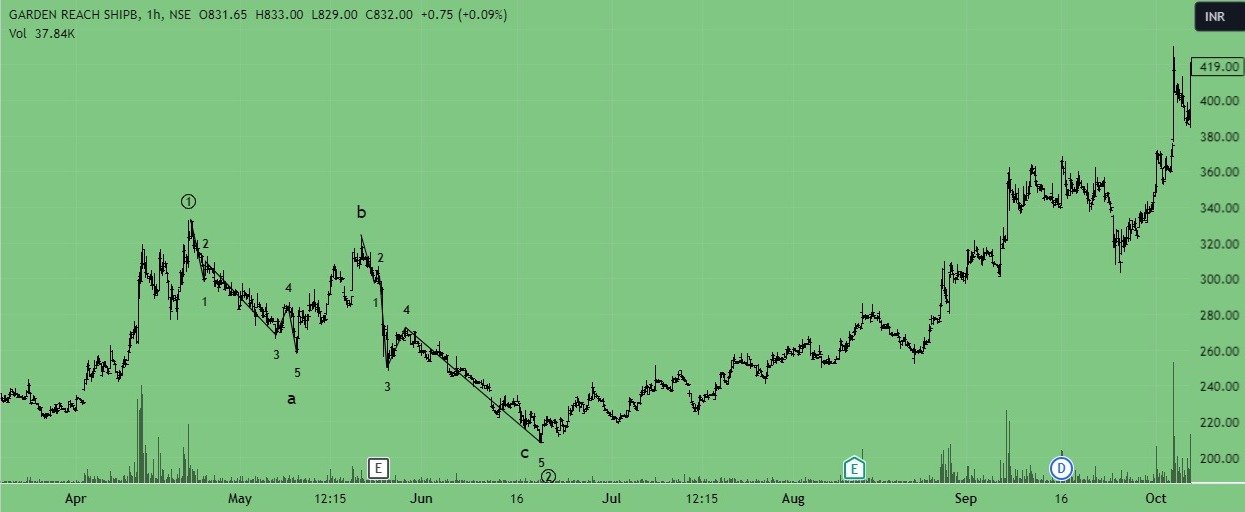Elliott Wave theory posits that following each corrective phase, a motive phase emerges, prompting traders to ready themselves for the subsequent motive wave. Corrective waves represent temporary counter-trend price movements within the prevailing market trend, maintaining balance and preventing trends from becoming overly extended.
In Short
One of the most important aspects of Elliott Wave theory is the idea that after each corrective phase, a motive phase inevitably begins, which traders and investors alike anxiously await. Recognizing and identifying corrective waves is crucial for anticipating and preparing for the next motive wave.
This article discusses Elliott Wave Theory corrections and their role in predicting profitable motive waves. Even if identifying correction phases is difficult, follow the guidelines and avoid trying to profit during corrections.
What Is a Corrective Wave?
A corrective wave is a temporary counter-trend price movement within the overall direction of the current market trend, according to Elliott Wave Theory. Following a motive wave, the market usually encounters a corrective wave, which is a partial retracement of the preceding rise.
Corrective waves are important because they preserve balance while preventing trends from getting extended. Traders analyze corrective waves to identify potential entry points for trades and to understand the broader market structure within the Elliott Wave framework.
What Is a Corrective Pattern?
Elliott’s cycle has eight waves in all: five climbing and three descending. Concentrating just on the five rising waves that comprise the development phase reveals three motives and two correctives. Although the entire set of five waves reflects a single motive wave, the presence of three lesser-degree motives and two corrections inside this set must be recognized.
After the motive phase, the corrective phase consists of three waves, with two short-term waves separated by one correction. The internal waves of the five-wave impulse wave are typically labeled as 1, 2, 3, 4, and 5, while the three-wave corrective phase is labeled as a, b, and c.
How Many Waves are In a Corrective Wave?
- A corrective wave typically comprises three waves: two short-term directional waves separated by one correction.
- When concentrating on the five ascending waves (development phase), we observe a composition of three motive waves and two corrective waves.
- While the complete set of five waves represents a single impulse wave, it’s crucial to acknowledge the presence of three smaller-degree impulses and two corrections within this set.
- Following the motive phase, the corrective phase unfolds with three waves. Two of these waves align with the short-term direction, separated by a single correction.
- The five-wave impulse’s internal waves are typically numbered 1, 2, 3, 4, and 5, while the corrective phase’s three-wave phase is numbered a, b, and c.
What is Motive Wave and Corrective Wave?
Elliott Wave Theory identifies motive waves and corrective waves as crucial elements in forming market price movements.
1. Motive Wave
A motive wave is a directional price movement, driven by a prevailing trend, characterized by five sub-waves: 1, 2, 3, 4, and 5. These waves represent the advancing phase, while the corrective phases are waves 2 and 4. Motive waves are the core drivers of a trend.
2. Corrective Wave
A corrective wave is a temporary price movement that opposes the prevailing trend, aiming to counter excesses and balance the market. It consists of three sub-waves, A, B, and C, and is crucial for preventing excessive trends and adjusting before the next wave begins.
Five subwaves in A, three in B, and five in C form a complete zigzag correction. Because Wave C’s impulse is predictable, traders can easily predict the market’s direction and profit from its movement. Read more…
Difference Between Motive Wave and Corrective Wave
| Aspect | Motive Wave | Corrective Wave |
|---|---|---|
| Definition | The main trend waves in Elliott Wave Theory are directional price movements driven by the prevailing trend. | Market excesses aim to be corrected or balanced through a temporary price movement against the prevailing trend. |
| Wave Structure | Composed of five sub-waves labeled 1, 2, 3, 4, and 5. | Composed of three sub-waves labeled A, B, and C. |
| Sub-waves | The trend is driven by advancing waves 1, 3, and 5, while the phases of waves 2 and 4 are corrective phases within the motive wave. | The A wave initiates the correction; the B wave temporarily opposes it; and the C wave completes it. |
| Role in Trend | It serves as the main catalyst for a trend, establishing its dominance in the market. | It functions as a countertrend, offering equilibrium and averting overindulgence in trends. |
| Market Sentiment | Strong directional sentiment often indicates the continuation of the trend. | The market temporarily opposes the trend, indicating that it must adapt or "correct" before continuing. |
| Phase Timing | The duration is typically shorter, thereby maintaining the primary trend over time. | They typically last longer and are perceived as pauses or pullbacks in the trend. |
| Importance in Analysis | It helps in identifying the trend direction and strength; the motive wave's structure confirms trend progression. | Corrective waves are crucial for predicting trend reversals and comprehending market modifications. |
| Examples | Impulse waves (most common), Diagonal waves (sometimes seen in leading or ending positions). | Zigzag, Flat, Triangle patterns, which vary based on the extent and style of correction. |
What is Correction in Trading?
In trading, a correction refers to a temporary adjustment in the price of an asset, which helps stabilize the market and prevent prolonged trends. Traders should be patient during corrections, avoiding quick decisions. They can observe market mood, change strategy, and locate advantageous entry points while waiting. This patience is consistent with risk management concepts and increases the likelihood of making well-timed and informed trading decisions when the correction ends and the trend restarts.
What Happens After Elliott Wave C?
We expect the market to experience a reversal or a change in trend direction following wave C, the final wave in a corrective series. The completion of wave C signifies the conclusion of the corrective phase and prepares the market for a resumption of the larger trend. Traders often look forward to the emergence of a new impulse wave after Wave C, as this indicates the start of the next cycle within the Elliott Wave framework.
The direction of the subsequent impulse wave is determined by the general market trend. If the corrective wave occurred during an uptrend, the subsequent impulse wave is likely to continue the upward trend. If the corrective wave occurred during a downturn, the next impulse wave may extend the downward momentum.
How Many Corrective Waves are There According to Elliott Theory?
On charts, we specify the corrective phases with the letters A, B, and C to make it clear. Waves A and C typically go in the opposite direction of the main trend. At this point, wave B serves as a corrective movement in the middle of these motions. This labeling allows us to clearly recognize and comprehend the various stages of market movements.
In this phase, we encounter a few more patterns. We divide them into smaller groups to facilitate understanding. The Simple Correction group includes the Zig-Zag, Flat, and Triangle patterns. Another category is the Complex correction, which includes double and triple three patterns.
The fundamental difference between the patterns is the number of sub-waves within waves A-B-C. Each pattern has a precise and exact number of sub-waves that must be identified for analysis. This approach makes it easier to identify and work with the market’s many corrective patterns.
Corrective Patterns
| Simple Correction | Complex Correction |
How Elliott Wave Theory Aided in Predicting the 1987 Crash and Generating Millions
In the months leading up to Black Monday in October 1987, renowned trader Paul Tudor Jones and his team at Tudor Investment Corporation analyzed a pattern that closely resembled the 1929 stock market crash. They integrated traditional technical analysis with Elliott Wave Theory, pinpointing an ending fifth wave across multiple degrees of trend. Jones observed not only the signs of overvaluation but also the market structure nearing completion of an impulsive wave cycle. This analysis prompted him to take action.
Jones made hundreds of millions of dollars one day when the market collapsed by over 22%, cementing his legacy as a trader who profited from panic using Elliott Wave insights.
What this story proves:
- Elliott Wave patterns are not merely theoretical; they can lead to tangible, profitable decisions.
- Traders benefit from knowledge of market wave structures.
- Predicting emotional moves can yield profits.
The corrective pattern is a simple three-wave structure, A-B-C. Zig-zag correction and its rules, guidelines, and patterns help traders of all levels predict market movements more accurately. Read more…
Final Thoughts
Corrective waves’ distinct patterns and structures help maintain market equilibrium by providing temporary counter-trend movements. Recognizing these adjustments helps you understand market dynamics and find smart entry points. The basics of corrective waves indicate that being patient and careful in spotting these phases is crucial for finding profitable chances when the next strong price movements happen. This knowledge may help traders analyze market movements and make informed decisions in the variable Elliott Wave Theory scenario.
FAQ
What happens after ABC wave?
Following an ABC wave pattern, traders frequently predict the continuation of the larger trend. Following the conclusion of the corrective ABC wave, the market normally enters a motive wave. This motive wave represents new momentum consistent with the major trend direction. Traders are eagerly watching this changeover since it has huge potential for profiting and capitalizing on the new trend.
What are the three ways waves change their movement?
Waves alter direction in three primary ways: reversal, continuation, and correction. Reversals happen when a wave quickly changes direction, indicating a shift in market sentiment and maybe the start of a new trend. On the other hand, continuation patterns show a brief stop or consolidation inside a continuing trend, implying that the current market direction is likely to continue. Corrections are countertrend moves that temporarily go against the bigger trend, allowing traders to initiate or increase positions before the main trend resumes.
Disclaimer
This article is provided for informational purposes only and does not offer financial advice. Trading and investing involve risk, and past performance is not a guarantee of future outcomes. Before making investment decisions, readers should conduct their own research and consider their individual circumstances. The author and platform are not responsible for any financial losses or damages resulting from the use of this information. Get personalized advice from a trained financial counselor.














Leave a Reply